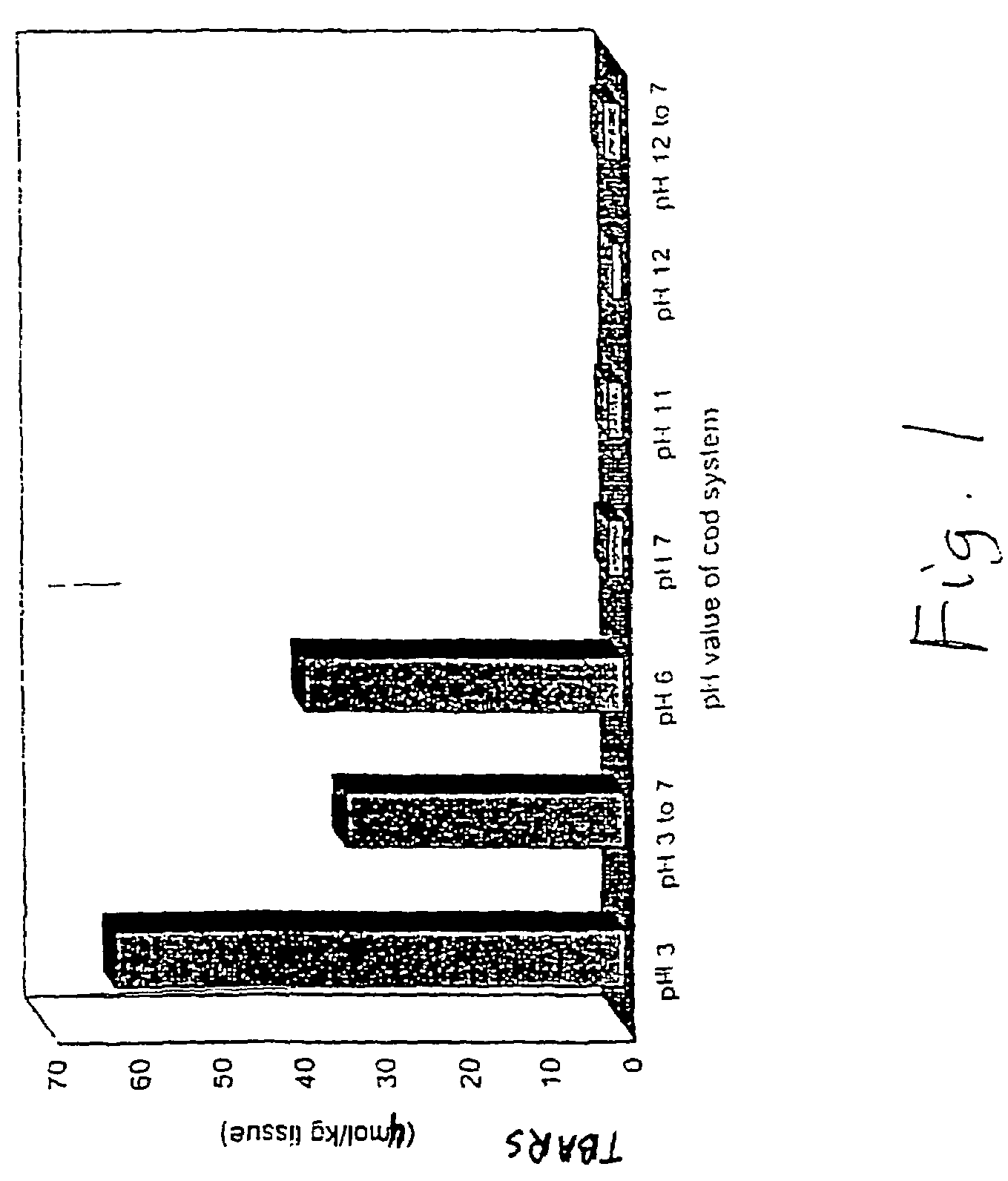High efficiency protein extraction
a protein extraction and high-efficiency technology, applied in the direction of peptides/protein ingredients, immunoglobulins, peptides, etc., can solve the problems of low-value animal muscle (e.g., from fatty pelagic fish or poultry bone residues) that are usually undesirable, and the isolated protein is often characterized by unattractive textures, dark colors, and strong flavors. , to achieve the effect of minimizing the oxidative effect of deoxyhemoglob
- Summary
- Abstract
- Description
- Claims
- Application Information
AI Technical Summary
Benefits of technology
Problems solved by technology
Method used
Image
Examples
example 1
Titrating pH for Optimal Protein Solubilization
[0039]Preparation of fish. Excellent quality Atlantic cod was obtained from local fish processors. Cod muscle was well trimmed, ground to ⅛-inch pieces, mixed with nine parts cold (6° C.) deionized, distilled water for each part muscle, and homogenized in a Polytron® PCU 1 machine (Brinkman Instruments, Westbury, N.Y.) at a speed of 76 for 1 minute.
[0040]Alkaline solubilization. The pH of the cod homogenate was 6.85. One molar NaOH was added to the homogenates until it reached specific alkaline pH levels in the range of 9.04 to 11.50. The viscosities of the solutions at 4-6° C. at the specific pH values were measured with a Brookfield Model LVF® viscometer (Brookfield Engineering, Stoughton, Mass.) using a #3 or #4 spindle at 60 rpm. The manufacturer's supplied conversion chart was used to calculate viscosity. The mixture was then centrifuged at 9300 rpm in a No. 35 rotor (10,000×g) for 60 minutes using an L5-65B® ultracentrifuge, to fo...
example 2
Production of Cod and Mackerel Surimi
[0043]Cod was prepared as described in Example 1 above. Atlantic mackerel was also obtained from local fish processors and processed as described in Example 1. The mackerel was of Stage II quality as assessed using the method described in Kelleher et al., J. Food. Sci. 57:1103-1108 and 1119, 1992. The mixtures were adjusted to pH 10.5 to solubilize the protein. The mixtures were then centrifuged, and the aqueous layer collected as described in Example 1.
[0044]One molar HCl was added to the aqueous protein solution until it reached pH 5.5. The precipitated protein was collected by centrifuging at 15,000 rpm (34,600×g) in a No. 19 rotor for 20 minutes in a Beckman® L5-65B ultracentrifuge. The supernatant was decanted. A cryoprotectant solution containing 4% sucrose, 4% sorbitol, and 1.2% sodium tripolyphosphate was added to the protein pellet. The mixture was formed into surimi by chopping for 30 seconds using an Oskar® model chopper (Sunbeam-Oster...
example 3
Production of Protein Isolates from Herring Light Muscle
[0048]Preparation of fish. Fresh herring was obtained from D&B Bait, Gloucester, Mass., and transported on ice to the University of Mass. Marine Station (approx. 15 min. travel time). Upon arrival in the laboratory, the fish was graded visually and divided into four grades: In rigor, stage I, II, and III (Kelleher et al., J. Food. Sci. 57:1103-1108 and 1119, 1992). The post mortem age generally ranged between 6-36 hours. White muscle was manually excised and pushed through a 3 mm plate using a kitchen grinder (Kitchen Aid Inc., St. Joseph, Mich., USA).
[0049]Protein isolation. Ground muscle (120-300 g) was homogenized for 1 minute (speed 50, 120 V) with 9 volumes of ice-cold distilled water using a Kinematica Gmb H Polytron (Westbury, N.Y., USA) connected to a Variable autotransformer (Dayton, Ohio USA). The proteins in the homogenate were solubilized by drop-wise addition of 2N NaOH until reaching pH 10.8. The protein suspensio...
PUM
| Property | Measurement | Unit |
|---|---|---|
| temperature | aaaaa | aaaaa |
| pH | aaaaa | aaaaa |
| pH | aaaaa | aaaaa |
Abstract
Description
Claims
Application Information
 Login to View More
Login to View More - R&D
- Intellectual Property
- Life Sciences
- Materials
- Tech Scout
- Unparalleled Data Quality
- Higher Quality Content
- 60% Fewer Hallucinations
Browse by: Latest US Patents, China's latest patents, Technical Efficacy Thesaurus, Application Domain, Technology Topic, Popular Technical Reports.
© 2025 PatSnap. All rights reserved.Legal|Privacy policy|Modern Slavery Act Transparency Statement|Sitemap|About US| Contact US: help@patsnap.com

